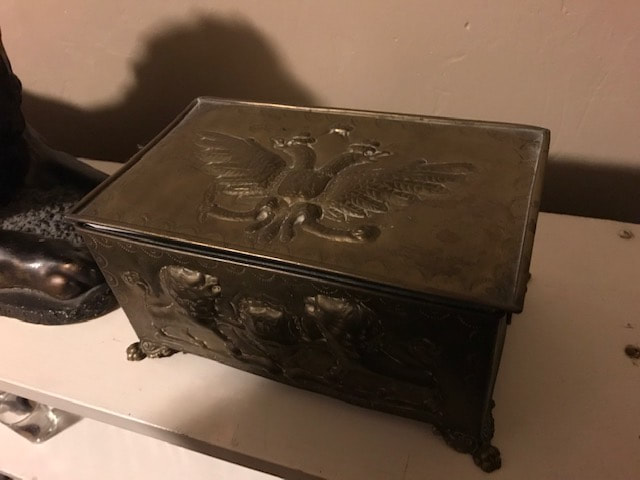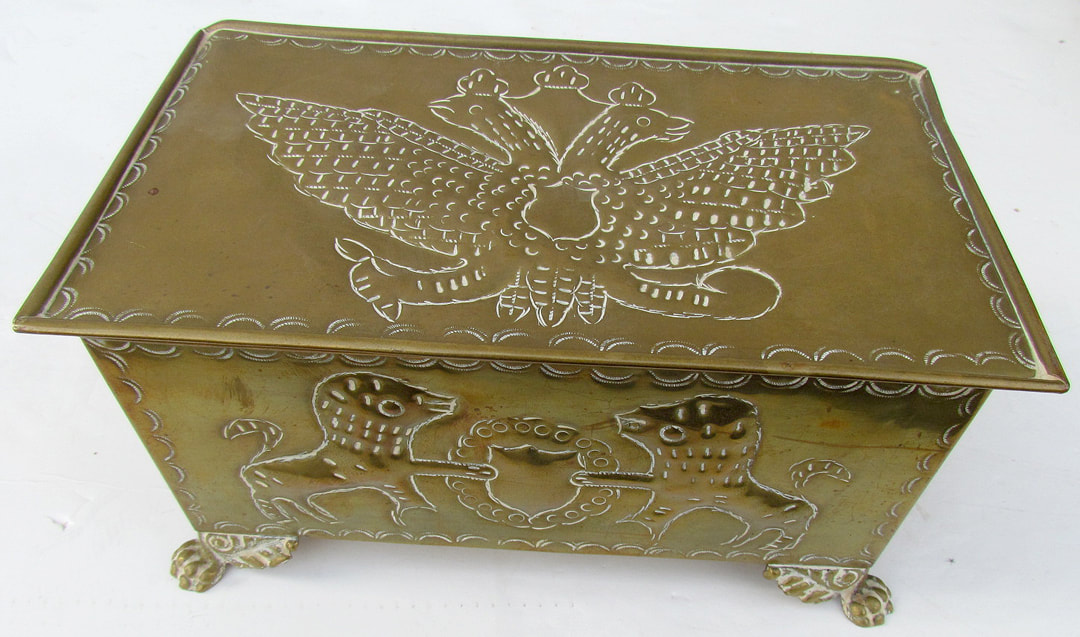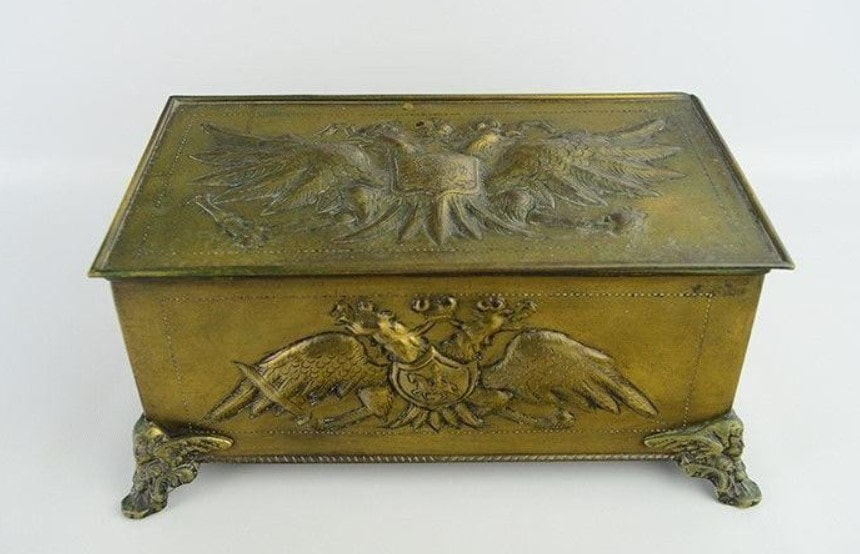|
Fake history is everywhere and often quite difficult to root out. Today, I’m going to break format a little bit to look at an inflated historical claim that is a little unusual. I came across this listing for an antique brass humidor for sale at a wildly inflated price of $795, and I had a hard time believing it. As many of you know, I collect unusual items with double-headed eagles on them, so I know a good deal about many different objects featuring the heraldic device. The humidor in question is a brass box with claw feet, lion pulls on the side and hand-embossed decorations of two lions supporting a shield on the front and the Romanov coat of arms on the lid. Take a look at how Kensington House Antiques of Maryland described the box: England and Russia signed the Anglo-Russian Entente in 1907, and along with the Entente Cordiale (England & France) and the Franco-Russian Alliance (France & Imperial Russia), the three nations formed the Triple Entente that eventually entered into World War I against Germany and the Austro-Hungarian Empire. The Anglo-Russian Entente greatly leveled the balance of power in Continental Europe and was widely celebrated. This box was created in honor of that event and may have been a mid-level diplomatic gift from a British representative to his Russian peer. Although we have not seen it, we understand that the same box exists with the French arms on the lid in place of Romanov double eagle. Bullshit. Every word of it is bullshit. How do I know this? Well, as it happens, I have an identical brass humidor sitting in my office, thus proving there is nothing unique about it, and there is no way a British diplomat commissioned it to give to a Russian one. The lions on the front of the box are not British. The U.K.’s arms are supported by a lion and a unicorn, while England is symbolized by three lions on a red field, not two supporting a shield. The quality of the embossing is, to put it kindly, questionable. It is quite obviously folk art, and it is far below the quality that a professional metalsmith would have produced in 1907. You will also find other people describing similar boxes as dating from the Napoleonic era. That’s wrong, too. I don’t believe the box to be either English or Russian, either, since every example known to me is currently located in the United States. There are dozens—perhaps even hundreds—of these boxes located all over the United States, and the quality of their embossing ranges from near-professional to almost a cartoonish disaster. As best I can tell, the designs were added by folk artists to mass-produced plain humidors to decorate them. The differences between the boxes can be attributed to the skill of the folk artist, but they also form a rough taxonomy that allows us to see how copies were made from copies by artists who were unfamiliar with the original and therefore didn’t understand the details they mimicked. The last copies in that daisy chain are stylized almost to the point of incoherence. [Update: Peter de Geus on Facebook informs me that the more likely explanation is that artists with varying skill sets tried and failed to copy patterns from a pattern-book that provided templates for metalwork like this.] That none of them was an official government issue is obvious from the amateurish mistakes in the heraldry, mixing elements from different versions of the Romanov arms over the course of the nineteenth century. The nicest such box I have ever seen featured two double-eagles, one on the lid and the other where the lions are on mine. The lions look uncannily like the early nineteenth century spread-winged version of the eagle on this box, and I do wonder if an early copyist misunderstood or misremembered the emblem, thus substituting lions that otherwise don’t seem in keeping with the theme. Otherwise, the lions may represent a Russian princely coat of arms unknown to me or are simply a European-style decoration imagined by an American artist. Presumably, there was an original humidor that all of these were copied from as the pattern spread across the United States. Whether it was the invention of an American folk artist or a Russian immigrant or whether a humidor made for a Russian prince served as the model, I cannot say. (Russian humidors and tea caddies produced under imperial warrant often featured the Romanov arms, though in much better renderings.)
What I can say is that the box is not rare, nor is it worth $795. It’s maybe a $75-$100 piece depending on the quality of the art. But telling an almost certainly false story about the box serving a diplomatic purpose commemorating the Anglo-Russian alliance leading up to the First World War ennobles what is, in reality, the work of common folk, and by making it an elite product, twists history to justify a hefty price.
9 Comments
Accumulated Wisdom
6/19/2019 10:52:45 am
Reminds me of the fake Hercules swords from Dr. White's blog. I have only seen one metal humidor before.($50, eBay) The two humidors, I have bought and resold were both wood. One from an antique shop was labeled "box $10". The other came from a yard sale. When, I picked it up to look at it, the man said, " That box has a hole in it. $1 if you're interested."
Reply
Paul
6/19/2019 10:55:48 am
Anyone who collects much of anything or is a knowledge seeker runs into it more often than not. Those narcissistic, pathological liars that profess that they are a professional so therefore they do not lie or the God blessers. If you get God Blessed in a deal, you know you have been had. With all the low cost labor in India and China, the copies are often better than the originals. This is on top of the folk artisian copies. BTW, just bought a copy of your Foundations of Atlantis book, looks to be a quite useful reference, thank you.
Reply
Machala
6/19/2019 11:48:03 am
With antiques and art, the provenance and the "story" behind a piece is what influences the sale and the price. Both can be - and often are - faked to increase the value of the object.
Reply
Jonathan
6/19/2019 12:17:35 pm
I collect antique swords and this sort of embellishment is rampant in sales listings. When you read something like what you shared above, you know to avoid that seller and to be suspicious of everything else they say.
Reply
vonmazur
6/19/2019 06:23:03 pm
Jonathan: I too collect antique swords and firearms, for over 50 years. Norm Flayderman told me years ago, "Buy the item, not the story..." Sellers now are not even as good as their predecessors were in the 70's..Their "War Stories" usually make no sense and they rely upon the buyer being uneducated about history, like the humidor above..
Reply
Treasure force commander
6/19/2019 12:27:45 pm
If some rube thinks that he’s purchased a rare item with an interesting connection to history that he comes to cherish as a fascinating conversation piece among his friends and family, then why piss in his Cheerios?
Reply
Momus
6/19/2019 01:06:05 pm
Go to any flee market and you will hear such stories dime-a -dozen. Some sellers throw them in even when they're completly gratuitous.
Reply
Kent
6/19/2019 01:25:57 pm
The ducal crest of Saxe-Coburg Gotha indeed has two lions and the two houses were related so calm the heck down. I do share your distrust of the story.
Reply
6/21/2019 05:12:29 am
It’s maybe a $75-$100 piece depending on the quality of the art.
Reply
Your comment will be posted after it is approved.
Leave a Reply. |
AuthorI am an author and researcher focusing on pop culture, science, and history. Bylines: New Republic, Esquire, Slate, etc. There's more about me in the About Jason tab. Newsletters
Enter your email below to subscribe to my newsletter for updates on my latest projects, blog posts, and activities, and subscribe to Culture & Curiosities, my Substack newsletter.
Categories
All
Terms & ConditionsPlease read all applicable terms and conditions before posting a comment on this blog. Posting a comment constitutes your agreement to abide by the terms and conditions linked herein.
Archives
July 2024
|
- Home
- Blog
- Books
-
Articles
-
Newsletter
>
- Television Reviews >
- Book Reviews
- Galleries >
- Videos
-
Collection: Ancient Alien Fraud
>
- Chariots of the Gods at 50
- Secret History of Ancient Astronauts
- Of Atlantis and Aliens
- Aliens and Ancient Texts
- Profiles in Ancient Astronautics >
- Blunders in the Sky
- The Case of the False Quotes
- Alternative Authors' Quote Fraud
- David Childress & the Aliens
- Faking Ancient Art in Uzbekistan
- Intimations of Persecution
- Zecharia Sitchin's World
- Jesus' Alien Ancestors?
- Extraterrestrial Evolution?
- Collection: Skeptic Magazine >
- Collection: Ancient History >
- Collection: The Lovecraft Legacy >
- Collection: UFOs >
- Scholomance: The Devil's School
- Prehistory of Chupacabra
- The Templars, the Holy Grail, & Henry Sinclair
- Magicians of the Gods Review
- The Curse of the Pharaohs
- The Antediluvian Pyramid Myth
- Whitewashing American Prehistory
- James Dean's Cursed Porsche
-
Newsletter
>
-
The Library
-
Ancient Mysteries
>
-
Ancient Texts
>
- Mesopotamian Texts >
-
Egyptian Texts
>
- The Shipwrecked Sailor
- Dream Stela of Thutmose IV
- The Papyrus of Ani
- Classical Accounts of the Pyramids
- Inventory Stela
- Manetho
- Eratosthenes' King List
- The Story of Setna
- Leon of Pella
- Diodorus on Egyptian History
- On Isis and Osiris
- Famine Stela
- Old Egyptian Chronicle
- The Book of Sothis
- Horapollo
- Al-Maqrizi's King List
- Teshub and the Dragon
- Hermetica >
- Hesiod's Theogony
- Periplus of Hanno
- Ctesias' Indica
- Sanchuniathon
- Sima Qian
- Syncellus's Enoch Fragments
- The Book of Enoch
- Slavonic Enoch
- Sepher Yetzirah
- Tacitus' Germania
- De Dea Syria
- Aelian's Various Histories
- Julius Africanus' Chronography
- Eusebius' Chronicle
- Chinese Accounts of Rome
- Ancient Chinese Automaton
- The Orphic Argonautica
- Fragments of Panodorus
- Annianus on the Watchers
- The Watchers and Antediluvian Wisdom
-
Medieval Texts
>
- Medieval Legends of Ancient Egypt >
- The Hunt for Noah's Ark
- Isidore of Seville
- Book of Liang: Fusang
- Agobard on Magonia
- Book of Thousands
- Voyage of Saint Brendan
- Power of Art and of Nature
- Travels of Sir John Mandeville
- Yazidi Revelation and Black Book
- Al-Biruni on the Great Flood
- Voyage of the Zeno Brothers
- The Kensington Runestone (Hoax)
- Islamic Discovery of America
- The Aztec Creation Myth
-
Lost Civilizations
>
-
Atlantis
>
- Plato's Atlantis Dialogues >
- Fragments on Atlantis
- Panchaea: The Other Atlantis
- Eumalos on Atlantis (Hoax)
- Gómara on Atlantis
- Sardinia and Atlantis
- Santorini and Atlantis
- The Mound Builders and Atlantis
- Donnelly's Atlantis
- Atlantis in Morocco
- Atlantis and the Sea Peoples
- W. Scott-Elliot >
- The Lost Atlantis
- Atlantis in Africa
- How I Found Atlantis (Hoax)
- Termier on Atlantis
- The Critias and Minoan Crete
- Rebuttal to Termier
- Further Responses to Termier
- Flinders Petrie on Atlantis
- Amazing New Light (Hoax)
- Lost Cities >
- OOPARTs
- Oronteus Finaeus Antarctica Map
- Caucasians in Panama
- Jefferson's Excavation
- Fictitious Discoveries in America
- Against Diffusionism
- Tunnels Under Peru
- The Parahyba Inscription (Hoax)
- Mound Builders
- Gunung Padang
- Tales of Enchanted Islands
- The 1907 Ancient World Map Hoax
- The 1909 Grand Canyon Hoax
- The Interglacial Period
- Solving Oak Island
-
Atlantis
>
- Religious Conspiracies >
-
Giants in the Earth
>
-
Fossil Origins of Myths
>
- Fossil Teeth and Bones of Elephants
- Fossil Elephants
- Fossil Bones of Teutobochus
- Fossil Mammoths and Giants
- Giants' Bones Dug Out of the Earth
- Fossils and the Supernatural
- Fossils, Myth, and Pseudo-History
- Man During the Stone Age
- Fossil Bones and Giants
- Mastodon, Mammoth, and Man
- American Elephant Myths
- The Mammoth and the Flood
- Fossils and Myth
- Fossil Origin of the Cyclops
- History of Paleontology
- Fragments on Giants
- Manichaean Book of Giants
- Geoffrey on British Giants
- Alfonso X's Hermetic History of Giants
- Boccaccio and the Fossil 'Giant'
- Book of Howth
- Purchas His Pilgrimage
- Edmond Temple's 1827 Giant Investigation
- The Giants of Sardinia
- Giants and the Sons of God
- The Magnetism of Evil
- Tertiary Giants
- Smithsonian Giant Reports
- Early American Giants
- The Giant of Coahuila
- Jewish Encyclopedia on Giants
- Index of Giants
- Newspaper Accounts of Giants
- Lanier's A Book of Giants
-
Fossil Origins of Myths
>
-
Science and History
>
- Halley on Noah's Comet
- The Newport Tower
- Iron: The Stone from Heaven
- Ararat and the Ark
- Pyramid Facts and Fancies
- Argonauts before Homer
- The Deluge
- Crown Prince Rudolf on the Pyramids
- Old Mythology in New Apparel
- Blavatsky on Dinosaurs
- Teddy Roosevelt on Bigfoot
- Devil Worship in France
- Maspero's Review of Akhbar al-zaman
- The Holy Grail as Lucifer's Crown Jewel
- The Mutinous Sea
- The Rock Wall of Rockwall
- Fabulous Zoology
- The Origins of Talos
- Mexican Mythology
- Chinese Pyramids
- Maqrizi's Names of the Pharaohs
-
Extreme History
>
- Roman Empire Hoax
- American Antiquities
- American Cataclysms
- England, the Remnant of Judah
- Historical Chronology of the Mexicans
- Maspero on the Predynastic Sphinx
- Vestiges of the Mayas
- Ragnarok: The Age of Fire and Gravel
- Origins of the Egyptian People
- The Secret Doctrine >
- Phoenicians in America
- The Electric Ark
- Traces of European Influence
- Prince Henry Sinclair
- Pyramid Prophecies
- Templars of Ancient Mexico
- Chronology and the "Riddle of the Sphinx"
- The Faith of Ancient Egypt
- Remarkable Discoveries Within the Sphinx (Hoax)
- Spirit of the Hour in Archaeology
- Book of the Damned
- Great Pyramid As Noah's Ark
- Richard Shaver's Proofs
-
Ancient Texts
>
-
Alien Encounters
>
-
US Government Ancient Astronaut Files
>
- Fortean Society and Columbus
- Inquiry into Shaver and Palmer
- The Skyfort Document
- Whirling Wheels
- Denver Ancient Astronaut Lecture
- Soviet Search for Lemuria
- Visitors from Outer Space
- Unidentified Flying Objects (Abstract)
- "Flying Saucers"? They're a Myth
- UFO Hypothesis Survival Questions
- Air Force Academy UFO Textbook
- The Condon Report on Ancient Astronauts
- Atlantis Discovery Telegrams
- Ancient Astronaut Society Telegram
- Noah's Ark Cables
- The Von Daniken Letter
- CIA Psychic Probe of Ancient Mars
- Scott Wolter Lawsuit
- UFOs in Ancient China
- CIA Report on Noah's Ark
- CIA Noah's Ark Memos
- Congressional Ancient Aliens Testimony
- Ancient Astronaut and Nibiru Email
- Congressional Ancient Mars Hearing
- House UFO Hearing
- Ancient Extraterrestrials >
- A Message from Mars
- Saucer Mystery Solved?
- Orville Wright on UFOs
- Interdimensional Flying Saucers
- Poltergeist UFOs
- Flying Saucers Are Real
- Report on UFOs
-
US Government Ancient Astronaut Files
>
-
The Supernatural
>
- The Devils of Loudun
- Sublime and Beautiful
- Voltaire on Vampires
- Demonology and Witchcraft
- Thaumaturgia
- Bulgarian Vampires
- Religion and Evolution
- Transylvanian Superstitions
- Defining a Zombie
- Dread of the Supernatural
- Vampires
- Werewolves and Vampires and Ghouls
- Science and Fairy Stories
- The Cursed Car
-
Classic Fiction
>
- Lucian's True History
- Some Words with a Mummy
- The Coming Race
- King Solomon's Mines
- An Inhabitant of Carcosa
- The Xipéhuz
- Lot No. 249
- The Novel of the Black Seal
- The Island of Doctor Moreau
- Pharaoh's Curse
- Edison's Conquest of Mars
- The Lost Continent
- Count Magnus
- The Mysterious Stranger
- The Wendigo
- Sredni Vashtar
- The Lost World
- The Red One
- H. P. Lovecraft >
- The Skeptical Poltergeist
- The Corpse on the Grating
- The Second Satellite
- Queen of the Black Coast
- A Martian Odyssey
- Classic Genre Movies
-
Miscellaneous Documents
>
- The Balloon-Hoax
- A Problem in Greek Ethics
- The Migration of Symbols
- The Gospel of Intensity
- De Profundis
- The Life and Death of Crown Prince Rudolf
- The Bathtub Hoax
- Crown Prince Rudolf's Letters
- Position of Viking Women
- Employment of Homosexuals
- James Dean's Scrapbook
- James Dean's Love Letters
- The Amazing James Dean Hoax!
- James Dean, The Human Ashtray
- Free Classic Pseudohistory eBooks
-
Ancient Mysteries
>
- About Jason
- Search
© 2010-2024 Jason Colavito. All rights reserved.








 RSS Feed
RSS Feed
